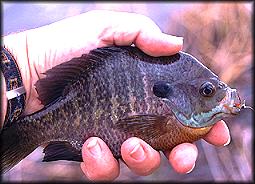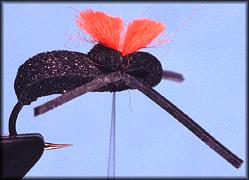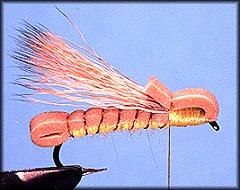One of the easiest ways to catch a bluegill is on a foam bug. And, since
these are some of the easiest flies to tie, I don't understand why more
folks don't use them. Do you suppose folks don't think any fly that simple
could possibly work? Hmmm, you got me wondering on that one.
Another thing I don't understand is why people won't use foam flies for
trout. I've used them with great success, but when I told others about it,
they almost always refused to even try these simple flies. It must be some
kind of unwritten rule I don't know about.
If you're looking for a sturdy strike indicator to use with your favorite
nymph, consider a foam bug. Not only is it a great indicator, it often
catches more fish than the nymph you suspend below it. For some reason,
fish are suckers for beetles with rubber legs. You won't catch me arguing
with a trout over the ethics of eating foam flies when everyone knows foam
bugs are only for panfish.
Some of the biggest bluegills I've had the privilege to catch fell for
foam bugs of several varieties. A few of the nicest bass I've landed were
fooled by foam bugs too. Add a few dozen perch and crappie, a few hundred
more trout, and you might get the picture. Foam is a great material to tie
flies with, and the fish seem to agree.
You can usually find a few colors of closed cell foam at the local fly
shop. But, if you really want to zoom in on the best selection of closed
cell foam, I've found the local craft stores to be great. For instance,
the local Ben Franklin craft store carries over a dozen colors of closed
cell sheet foam at less than two dollars a sheet. Comparing that to two or
three colors of foam in sheets that are half the size of those found in
craft stores and at least twice the price per sheet, you should be able to
make a firm decision on where to do the most economical shopping.
I usually use a paper cutter to slice my foam into nice, even strips about
a quarter inch wide. Scissors work fine, but since I already own a paper
cutter, and since I like even cuts of a fairly consistent width, I use my
paper cutter to do the job. Those roller-type pizza cutters rolled along a
straight edge also work well and provide a consistent width.
If you want to add some color and a hard back to your foam beetles,
consider adding an epoxy or Anglers Choice soft body back to your beetle
patterns. Create the humped back by dabbing epoxy or similar textured
materials onto the back with a brush or toothpick. Once the hump has
dried, you can color it with waterproof markers and if you wish, add
additional clear hump material over the colors.
Since whole books have been dedicated to foam bug patterns, it's obvious
I'll only scratch the surface of the possibilities with the three patterns
I'll be showing you. I'm more interested in showing you the techniques and
letting you apply them to patterns that use them; than I am in showing you
dozens of patterns you can find in other books that use these simple tying
techniques.
Let's start with a high visibility foam beetle.
|


















